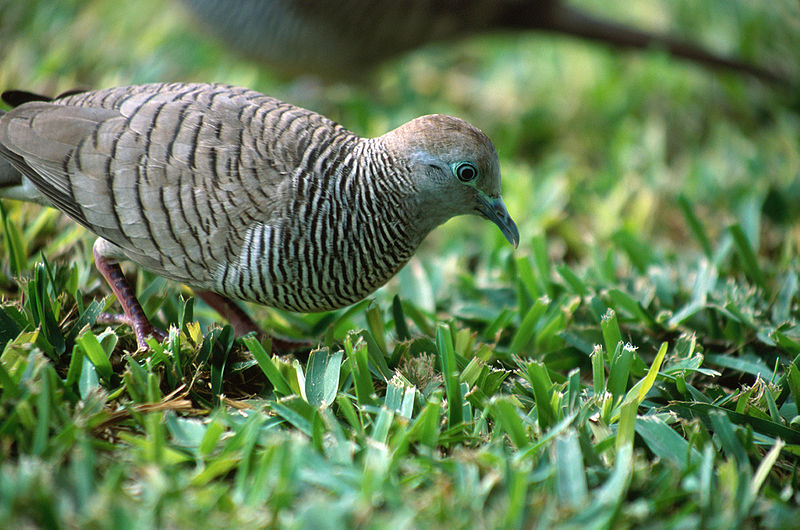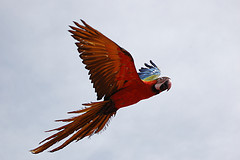In Part I of this article we examined the pros and cons of imprinting – the process wherein an animal comes to see adults of another species as its natural parents – as regards birds in zoos, the pet trade and conservation programs. Today I’d like to relate a few more of my experiences with imprinting as it related to the conservation of endangered birds and mammals.
Andean and California Condor Reintroductions
 Rare birds raised for use in future release/re-stocking programs present a unique set of challenges. Many are needed, and so pulling eggs to stimulate a second clutch is desirable. However, birds raised by hand or under foster parents of another species face poor prospects for survival in the wild.
Rare birds raised for use in future release/re-stocking programs present a unique set of challenges. Many are needed, and so pulling eggs to stimulate a second clutch is desirable. However, birds raised by hand or under foster parents of another species face poor prospects for survival in the wild.
I have worked with both Andean and California condor chicks that were destined for future release into natural habitats. These magnificent raptors are quick to imprint upon the people who feed them, so a novel solution was devised. Keepers assigned to hand-feed condor chicks worked from behind a curtain, and presented food in the beak of hand puppet which closely resembled the head of an adult condor. I’m happy to report that many hand-reared condors of both species successfully made the transition from captive to free-living existence.
Cows as Surrogate Mothers for Rare Species
Certain endangered mammals with which I’ve worked have presented particularly difficult dilemmas. Gaur (rare wild cattle native to India and Southeast Asia) for example, breed readily in captivity but produce only 1 calf every 3-4 years. In order to bolster this species’ numbers, captive female gaurs are sometimes chemically induced to produce several eggs instead of the usual single egg.
The extra eggs are implanted into domestic cows, which then give birth to and successfully raise baby gaurs. However, cow-raised gaurs are not accepted by parent-raised gaurs. Gaurs that are raised among domestic cows do not acquire normal gaur behaviors (i.e. appropriate reactions to dominant animals) and are attacked when integrated into gaur herds. They rarely breed, and hence do not contribute to the species’ survival prospects.
Gorillas
 Captive-born female gorillas are often unable to raise their own young, lacking examples and mentors in the form of older females, as would be the case in the wild (some zoos have tried “training films, to no avail!). Hence many must be hand-raised (please see photo), but these too are often ostracized by other gorillas and rarely reproduce.
Captive-born female gorillas are often unable to raise their own young, lacking examples and mentors in the form of older females, as would be the case in the wild (some zoos have tried “training films, to no avail!). Hence many must be hand-raised (please see photo), but these too are often ostracized by other gorillas and rarely reproduce.
Further Reading
You can read more about the California condor reintroduction program at http://www.bigsurcalifornia.org/condors.html.
 That Bird Blog – Bird Care and History for Pet Birds
That Bird Blog – Bird Care and History for Pet Birds


 The zebra dove ranks just behind the closely related diamond dove and the ring dove in popularity, and captive bred birds are readily available. Ranging from Thailand south through Malaysia and Indonesia to Australia, escaped and released zebra doves are also established in Hawaii, Madagascar, California and other places.
The zebra dove ranks just behind the closely related diamond dove and the ring dove in popularity, and captive bred birds are readily available. Ranging from Thailand south through Malaysia and Indonesia to Australia, escaped and released zebra doves are also established in Hawaii, Madagascar, California and other places. However, rare finches raised by zebra or society finches often pick up the songs of their foster parents, and prefer the foster species over their own species as mates. As you can imagine, this seriously hampers efforts to increase the population of the endangered birds.
However, rare finches raised by zebra or society finches often pick up the songs of their foster parents, and prefer the foster species over their own species as mates. As you can imagine, this seriously hampers efforts to increase the population of the endangered birds. Imagine for a moment what it would be like, if you took your clipped parrot outside, let go of his feet and a 25 mph wind gust took him out of your hands never to see him again. For many, that is unfortunately a very common story.
Imagine for a moment what it would be like, if you took your clipped parrot outside, let go of his feet and a 25 mph wind gust took him out of your hands never to see him again. For many, that is unfortunately a very common story. Freestyle Flying™ isn’t for everyone, but it is for every bird. And if you’re the kind of person who is willing to put in a lot of time, energy, and research, this can be the best quality of life that you can offer your parrot.
Freestyle Flying™ isn’t for everyone, but it is for every bird. And if you’re the kind of person who is willing to put in a lot of time, energy, and research, this can be the best quality of life that you can offer your parrot. To make a quick, evasive turn) As your parrots become more and more confident and skilled, they’ll start to experiment with evasive maneuvers that they use in the wild to evade predators such as hawks and eagles. They’ll actually flip upside down, flap, turn right side up, upside down, etc until they have successfully evaded the predator. Although I have seen this used twice to actually evade a hawk (or flock of seagulls), they also love just practicing it on their own.
To make a quick, evasive turn) As your parrots become more and more confident and skilled, they’ll start to experiment with evasive maneuvers that they use in the wild to evade predators such as hawks and eagles. They’ll actually flip upside down, flap, turn right side up, upside down, etc until they have successfully evaded the predator. Although I have seen this used twice to actually evade a hawk (or flock of seagulls), they also love just practicing it on their own.